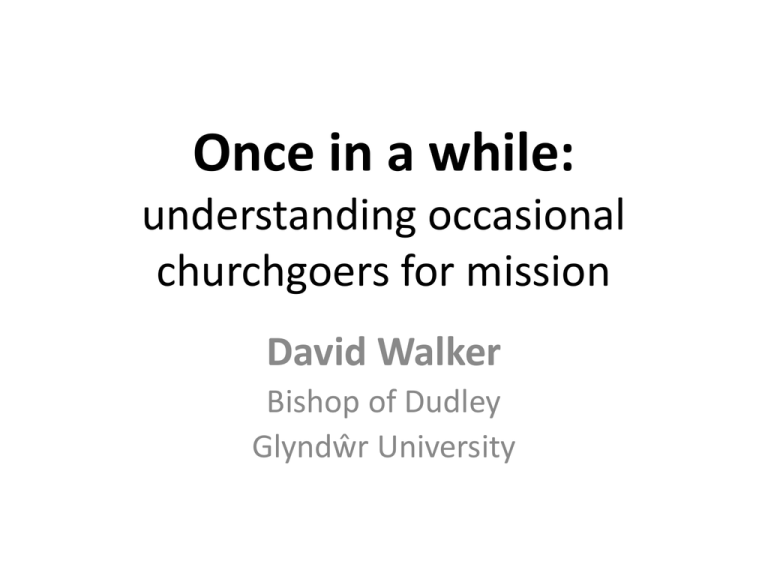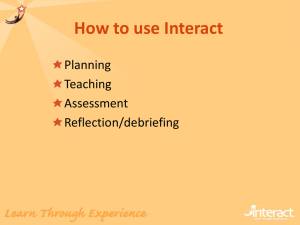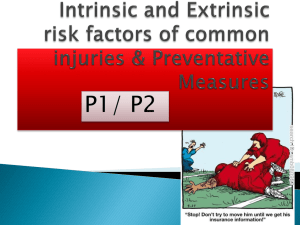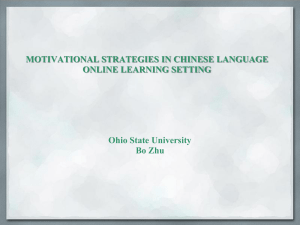
Once in a while:
understanding occasional
churchgoers for mission
David Walker
Bishop of Dudley
Glyndŵr University
A conceptual model
• Reflecting on the rural context
• Belonging without believing?
– Affiliation, belief and practice
• A fourfold model of belonging
– Activities
– Events
– People
– Places
The 2007 Harvest sample
• 1454 adults from 27 C of E churches in Worcester
Diocese
• 326 claimed to attend church less than monthly
• 775 claimed to attend nearly every week
• The occasional churchgoers can be looked at on their
own and then contrasted with the frequent church
attending group
• Occasional churchgoers were younger than frequent
– 30% between 20 and 49 as opposed to 14%
– 20% aged 70 or over as opposed to 35%
• No significant gender difference
Harvest results 1
The occasional churchgoer at Harvest:
• is pluralist as regards world faiths
• does not treat the bible as historically accurate
• regards church attendance as an optional extra
• continues to believe in God and Jesus Christ
• chooses to self-identify as Christian
• is not seeking more modern or interactive styles
of worship than appeal to regular churchgoers
• is not attracted by a vague notion of spirituality.
How occasional churchgoers belong
• Belonging with people
– Congregational belonging
– Pastoral support
– Personal intimacy
• Belonging with place
• Belonging in the community
– Involvement in other groups
– Links between congregation and other groups
The five Marks of Mission
•
•
•
•
To proclaim the good news of the Kingdom
To teach, baptize and nurture new believers
To respond to human need by loving service
To seek to transform unjust structures of
society
• To strive to safeguard the integrity of creation
and to sustain the life of the earth
Mission with occasional churchgoers 1
Pastoral Care
(to respond to human need by loving service)
– The vicar is still visible!
– Informal pastoral care has some reach
– Some occasional churchgoers may have the links
to help provide pastoral care
Mission with occasional churchgoers 2
Engaging with society and world
to seek to transform unjust structures of society
to strive to safeguard the integrity of creation and to
sustain the life of the earth
– include in church-based or church-managed social,
environmental and ethical concerns.
– A preference for activity assists regular churchgoers to
provide the infrastructure to sustain local organisations so
that occasional churchgoers, who are more predisposed to
one off engagement or require a strong lead from people,
can make their own contribution as agents of this mission
work
– The value of event based campaigns and efforts
Mission with occasional churchgoers 3
Evangelism and nurture
to proclaim the good news of the Kingdom
to teach, baptize and nurture new believers
– the value of personal relationships
– how buildings are presented and interpreted will have
a significant role to play
– The outcome of evangelism and nurture may not be
Sunday attendance
– the importance of diversity in how Christian faith is
lived out and expressed
Cathedral Studies
• Cathedrals as a “success phenomenon”
– Average 34% growth in congregations over ten years
• Three areas of study
– Cathedral visitors (see Tania ap Sion for example)
– Cathedral congregations (see Emyr Williams for example)
– Attendees at cathedral events (my area of interest)
• Why study cathedral events?
– Large numbers of occasional churchgoers
– A dimension of the Walker model of belonging
– Expectation of a sample with a wide demographic range
The Cathedral Christmas sample
• 460 out of 1151 attend church less than 6
times a year
• 30% of occasional churchgoers were below
the age of 40, 29% were aged 60 and above
• 44% of occasional churchgoers were men
• 81% were baptised, 42% confirmed
• 59% go to church less often nowadays
• 8% on an electoral roll
Christmas Carol findings
• Engaging with story as gateway to mystery not
as doctrine
• A high expectation of encounter with God
• Strongly pluralist
• Morality matters above belief
• Supportive of public religion
• Low private piety
• No practice of reading scripture
A different quantitative method
• Analysis of whole sample – what does a
congregation with many occasional
churchgoers look like?
• Using correlations and regression, including
frequency of attendance as a variable
• Using a construct – religious orientation from
the field of Psychology of Religion
Religious Orientation - Intrinsic
• Persons with this (Intrinsic) orientation find their
master motive in religion. Other needs, strong as
they may be, are regarded as of less ultimate
significance, and they are, so far as possible,
brought into harmony with the religious beliefs
and prescriptions. Having embraced a creed the
individual endeavours to internalize it and follow
it fully. It is in this sense that he lives his religion.
(Allport and Ross 1967)
Religious Orientation - Extrinsic
• Persons with this (Extrinsic ) orientation are disposed
to use religion for their own ends. The term is
borrowed from axiology, to designate an interest that is
held because it serves other, more ultimate interests.
Extrinsic values are always instrumental and utilitarian.
Persons with this orientation may find religion useful in
a variety of ways - to provide security and solace,
sociability and distraction, status and self-justification.
The embraced creed is lightly held or else selectively
shaped to fit more primary needs. In theological terms
the extrinsic type turns to God, but without turning
away from self.
(Allport and Ross 1967)
Religious Orientation - Quest
• An individual who approaches religion in this
way recognises that he or she does not know,
and probably never will know, the final truth
about such matters. But still the questions are
deemed important and however tentative and
subject to change, answers are sought. There
may not be a clear belief in a transcendent
reality, but there is a transcendent, religious
dimension to the individual's life.
Batson and Ventis (1982)
Religious orientation and churchgoing
• Scales work well with a group containing many
occasional churchgoers
• Associations between religious orientation
and churchgoing frequency
– Strong positive correlation with intrinsic (.66)
– Significant positive correlation with quest (.26)
– No association with extrinsic
Constructing a measure for
Traditional Christmas beliefs
Statement
I believe that shepherds visited Jesus’ birthplace
I believe that wise men visited the infant Jesus
I believe that Jesus was born in a stable
I believe that Jesus was born of a virgin mother
I believe that the bible predicted Jesus’ birth
* I don’t believe the Christmas story literally
r
.87
.87
.89
.88
.90
.91
yes %
64
64
61
50
63
35
Cronbach’s Alpha = .90
* indicates the responses to this statement are reverse coded; figure is for
those who disagreed.
yes% = the percentage who agreed or agreed strongly with the statement
r = item rest of test correlation
Correlations of the new measure
Variable Trad I
sex
.00 .08
age
.20 .39
att
.40 .66
Extrinsic .25 .27
Quest
.07 .39
Intrinsic .58
bold text = p<.001
Q
E
att age
-.07 .02 -.07 -.09
.08 -.11 .33
.29 .05
.36
Path model for regression
Religious orientation and prejudice
• Attempts to answer the question as to why religious
people show more prejudice
• Association of intrinsic religiosity with lower levels of
prejudice
• Distinction between proscribed and non-proscribed
prejudices
• Homosexuality as a non-proscribed prejudice with
positive associations with intrinsic religiosity
• This disappears after controlling for fundamentalist
beliefs
• No previous work studying quest orientation
Attitudes towards homosexuality
disagree disagree not sure agree
strongly
Gay marriage
Gay bishops
20
15
19
15
23
24
agree
strongly
26
29
13
17
N = 381
Gay marriage = “Homosexual couples should be allowed to marry”
Gay bishops = “It should be possible for a gay man to be made a bishop”
Correlations with church attendance:
Gay marriage = -.28; Gay bishops = -.21
Discussion on homonegativity
• Women show lower levels of homonegativity than men
• Younger people show lower levels of homonegativity than
older ones
• Attitudes towards gay marriage are less positive than
towards gay bishops – the civil partnership factor?
• Intrinsic religiosity is associated with higher levels of
homonegativity as expected.
• Quest religiosity is associated with lower levels of
homonegativity
• Does the proscribed/non-proscribed distinction not work
for Quest orientation?
• Does Quest orientation capture the inclusive and
affirmative element in Christian faith?
Conclusions
• Occasional churchgoers are different, not just a bit less
committed
• They and their real faith need and deserve to be
understood as part of our engagement with them
• Churches that are led by one dominant orientation may
not understand the needs of others
• Occasional churchgoers are collaborators in mission
not just its recipients
• Events matter in their own right
• Quest orientation may open up new understanding of
those who don’t fit the dominant model








